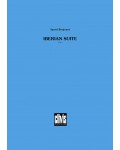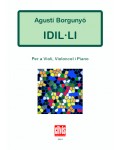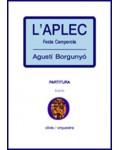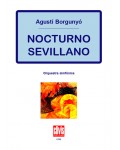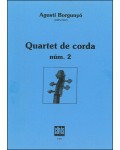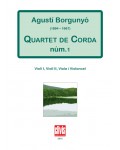
No products
Prices are tax included
Product successfully added to your shopping cart
There are 0 items in your cart. There is 1 item in your cart.
- English
- Castellano
- Català
Born in Sabadell in1894, he began his musical studies at the city’s Escola Municipal de Música (Municipal Music School) under Josep Plans and Cebrià Cabané. He later furthered his studies of composition and harmony in Barcelona under Manuel Burgués. By the age of sixteen he had already mastered anumber of instruments and had joined Barcelona’s MunicipalBand.
In 1915, at the age of 21, he left for the United States,where he began by writing light music for a dance orchestra,of which he was also a member. Between 1922 and 1929, when he lived in Washington DC, he wrote a great number of ballets, suites and operettas in an American style,which were premiered and which received vary favorable reviews in the Washington Times and the Washington Herald, which noted his ability to capture fashionable popular rhythms. It was during this time that he was Artistic Directorof the Meyer Davis Orchestra, which was extremely popular in the city in the twenties. In the early thirties, he orchestrated on an exclusive basis for the famous singer Kate Smith, at the Columbia Broadcasting System (CBS) radiostation in New York. Next, he produced scores for the city’s Wor Symphony Orchestra, under the direction of Alfred Wallenstein. The director commissioned him to write workswith a Spanish air, which is how they were broadcast by the station.
Between 1941 and 1960 he was Musical and Artistic Director of the National Broadcasting Symphony Orchestra under a programme sponsored by Firestone. He orchestrated a number of singers, including Mario del Mónaco and Renata Tebaldi. After his return to Catalonia in 1963, he continued to receive commissions for informational documentaries from the US Department of Agriculture until his death in July 1967. He is author a an extremely wide range of works, including 150 sardanes and other compositions for the cobla, more than 50 works for voice and piano, and some thirty choral works, most of which are based of the works of poets and other writers from Sabadell: a great number of pieces for piano, two string quartets, a trio and works for string andsymphonic orchestras, amongst which we would highlight "L’aplec", premiered in 1956 by the Orquestra Municipal de Barcelona under the baton of Eduard Toldrà, "Emporion", "Nocturno Sevillano", "Danza Ibérica núm. 1" and the "Suite Ibérica"; the three-act operetta "Maryana" and the ballets "La festa de carrer" and "The Damask Rose".
-
Iberian Suite
Edition: PrintedBorgunyó composed this work in 1940. Developed as a suite, includes four movements or dances from several regions of the Iberian Peninsula : 1. Aragon (jota) 2. Andaluza (saeta) , 3. Galicia (danza), 4. Castilla (paso doble). Score available only in visione. Materials on hire.
26,00 € -
Iberian Suite
Edition: DigitalBorgunyó composed this work in 1940. Developed as a suite, includes four movements or dances from several regions of the Iberian Peninsula : 1. Aragon (jota) 2. Andaluza (saeta) , 3. Galicia (danza), 4. Castilla (paso doble). Score available only in visione. Materials on hire.
26,00 € -
Idil·li
Edition: DigitalThe Idil·li per a trio (violin, cello and piano) by Agustí Borgunyó is a short work of less than six minutes and yet it is full of intensity, lyricism and expressive power.
7,56 € -
Idil·li
Edition: PrintedThe Idil·li per a trio (violin, cello and piano) by Agustí Borgunyó is a short work of less than six minutes and yet it is full of intensity, lyricism and expressive power.
13,00 € -
L'Aplec
Edition: DigitalThe name Aplec stems from the open and Catalan nature of the tunes, with a very populist bent, which are in exquisite taste and treated with a refined counterpoint and rich orchestration.
22,17 € -
L'Aplec
Edition: PrintedThe name Aplec stems from the open and Catalan nature of the tunes, with a very populist bent, which are in exquisite taste and treated with a refined counterpoint and rich orchestration.
38,12 € -
L'Aplec (Wind orchestra version)
Edition: PrintedArrangement for symphonic band by Joan Lluís Moraleda.
30,00 € -
L'Aplec (Wind orchestra version)
Edition: DigitalArrangement for symphonic band by Joan Lluís Moraleda.
20,95 € -
Nocturno sevillano
Edition: DigitalSevillian Nocturne is a symphonic piece with music that has clear roots in Seville. The melisma typical of Arabic-inspired music is ever-present, and the sound of the guitar is anticipated in the arpeggios of the harp and piano, which take on soloist parts at certain points of the work.
11,64 € -
Nocturno sevillano
Edition: PrintedSevillian Nocturne is a symphonic piece with music that has clear roots in Seville. The melisma typical of Arabic-inspired music is ever-present, and the sound of the guitar is anticipated in the arpeggios of the harp and piano, which take on soloist parts at certain points of the work.
20,00 € -
-


